配对题。请从选项中选择与之相对应的研究方法。 What is the effect of team-based learning achievement of the students?A.Survey researchB.Experimental researchC.Correlational researchD.Causal-comparative research
题目
配对题。请从选项中选择与之相对应的研究方法。 What is the effect of team-based learning achievement of the students?
A.Survey research
B.Experimental research
C.Correlational research
D.Causal-comparative research
相似考题
更多“配对题。请从选项中选择与之相对应的研究方法。 What is the effect of team-based learning achievement of the students?”相关问题
-
第1题:
请认真阅读下面短文,从短文后各题所给的A、B、C、D四个选项中,选出最佳选项,
The requirements for high school graduation have just changed in my community. As a result, all students must 36 sixty hours of service learning, 37 they will not receive a diploma. Service learning is academic learning that also helps the community. 38 of service learning include cleaning up a polluted river, working in a soup kitchen, or tutoring a student. 39 a service experience, students must keep a journal(日志)and then write a 40 about what they have learned.
Supporters claim that there are many 41 of service learning. Perhaps most importantly, students are forced to think 42 their own interests and become 43 of the needs of others. Students are also able to learn real-life skills that 44 responsibility, problem-solving, and working as part of a team. 45 , students can explore possible careers 46 service learning.
For example, if a student wonders what teaching is like, he or she can choose to work in an elementary school classroom a few afternoons each month. 47 there are many benefits, opponents (反对者) 48 problems with the new requirement. First, they 49 that the main reason students go to school is to learn core subjects and skills. Because service learning is time-consuming, students spend 50 time studying the core subjects. Second, they believe that forcing students to work without 51 goes against the law. By requiring service, the school takes away an individual's freedom to choose.
In my view, service learning is a great way to 52 to the community, learn new skills, and explore different careers. 53 , I don' t believe you should force people to help others – the 54 to help must come from the heart. I think the best 55 is one that gives students choices: a student should be able to choose sixty hours of independent study or sixty hours of service. Choice encourages both freedom and responsibility, and as young adults, we must learn to handle both wisely.
36. A. spend B. gain C. complete D. save
正确答案:C
-
第2题:
What's the overall goal of English teaching in basic education stage?A.Increase students' vocabulary and grammar of the knowledge.
B.Improve students' English learning and foreign cultural interesting.
C.Cultivate students' ability of listening and spoken English.
D.Cultivate students' comprehensive capability of language.
答案:D解析:考查英语教学目标。基础教育阶段英语教学的总体目标是培养学生综合运用语言的能力。 -
第3题:
请阅读Passage 1, 完成第小题。
Passage 1
In recent years,however, society has come to understand the limitations of schools that merelysort and rank students. We have discovered that students in the bottomone-third to one-half of the rank order-plus all who drop out before beingranked-fail to develop the foundational reading, writing, and mathematicalproficiencies needed to survive in, let alone contribute to, an increasinglytechnically complex and ethnically diverse culture. So today, in asking schoolsto leave no child behind, society is asking that educators raise up the bottomof the rank-.order distribution to a specified level of competence. We callthose expectations our?? "academicachievement standards". Every state has them, and, as a matter of publicpolicy, schools are to be held accountable for making sure that all studentsmeet them.
?To be clear, themission of sorting has not been eliminated from the schooling process. For theforeseeable future, students will still be ranked at the end of high school.However, society now dictates that such a celebration of differences m amountlearned must start at a certain minimum level of achievement for all.
??The implications of this change in missionfor the role of assessment are profound. Assessment and grading proceduresdesigned to permit only a few students to succeed (those at the top of therank-order distribution) must now be revised to permit the possibility that allstudents could succeed at some appropriate level. Furthermore, procedures thatpermitted?? (perhaps even encouraged)some students to give up in hopelessness and to stop trying must now be replacedby others that promote hope and continuous effort. In short, the entireemotional environment surrounding the prospect of being evaluated must change,especially for perennial low achievers.
??The students' missionis no longer merely to beat other students in the achievement race. At leastpart of their goal must be to become competent. Teachers must believe that allstudents can achieve a certain level of academic success, must bring all oftheir students to believe this of themselves, must?accommodate?the factthat students learn at different rates by making use of differentiatedinstruction, and must guide all students toward the attainment of standards.
??The driving dynamicforce for students cannot merely be competition for an artificial scarcity ofsuccess. Because all students can and must succeed in meeting standards,cooperation and collaboration must come into play. The driving forces must beconfidence, optimism, and persistence-for all, not just for some. All studentsmust come to believe that they can succeed at learning if they try. They musthave continuous access to evidence of what they believe to be credible academicsuccess, however small. This new understanding has spawned increased interestin formative assessment in recent years.
What do the "academic achievement standards" in Paragraph 1 refer to?A.The driving dynamic forces for all students who need to survive in society.
B.Confidence, optimism, and persistence that students need in order to succeed.
C.Differentiated levels of competence specified for students with different abilities.
D.The missions of students who want to beat others in their achievement race in school.答案:C解析:细节题。根据关键词所在文中的句子“We call those expectations our.Academicachievement standards'. ”可知其对应的就是“those expectations”所指的内容。根据前面一句话“…societyis asking that educators raise up the bottom of the rank-order distribution toa specified level of competence.”可确定答案为C。 -
第4题:
请从所给的选项中,选择唯一的一项填在问号处,使之呈现一定的规律性( )。 答案:D解析:图形元素组成相似,考察样式类。观察图形元素发现组成元素种类数量一致,只是排列次序不同,考虑遍历。题干每一行和第二行四角星、月亮、黑圆圈、太阳、五角星每一横行重复出现,第三横行缺四角星和黑圆围,缺啥补啥,得到答案为D选项。
答案:D解析:图形元素组成相似,考察样式类。观察图形元素发现组成元素种类数量一致,只是排列次序不同,考虑遍历。题干每一行和第二行四角星、月亮、黑圆圈、太阳、五角星每一横行重复出现,第三横行缺四角星和黑圆围,缺啥补啥,得到答案为D选项。 -
第5题:
请从所给的四个选项中,选择最合适的一个,使之呈现一定的规律性: AA
AA
BB
CC
DD答案:C解析:前两个图形叠加后去异存同得到第三个图形。
故正确答案为C。 -
第6题:
请从所给的选项中,选择唯一的一 项填在问号处, 使之呈现一定的规律性( )。
 答案:A解析:本题考察样式+数量类。观察题千第一横行正方形, 曲线,四条曲线:第二横行十字交叉两条线,斜直线,斜的十字交叉线;第三横行长方形,曲线,问号?得出规律,用第一列的数量,第二列的形状组成第三列的图形,长方形两长两短。所以答案为A选项。
答案:A解析:本题考察样式+数量类。观察题千第一横行正方形, 曲线,四条曲线:第二横行十字交叉两条线,斜直线,斜的十字交叉线;第三横行长方形,曲线,问号?得出规律,用第一列的数量,第二列的形状组成第三列的图形,长方形两长两短。所以答案为A选项。 -
第7题:
对于通过小额支付系统办理的他代本通存业务,若需账务调整,且错账类型为挂账,则产生的会计分录为()。
- A、请对应上面图片内容选择对应选项
- B、请对应上面图片内容选择对应选项
- C、请对应上面图片内容选择对应选项
- D、请对应上面图片内容选择对应选项
正确答案:C -
第8题:
单选题Passage1Today's adults grew up in schools designed to sort us into the various segments of our social and economic system. The amount of time available to learn was fixed: one year per grade. The amount learned by the end of that time was free to vary: some of us learned a great deal;some,very little. As we advanced through the grades,those who had learned a great deal in previous grades continued to build on those foundations. Those who had failed to master the early prerequisites within the allotted time failed to learn that which followed. After 12 or 13 years of cumulative treatment of this kind,we were,in effect,spread along an achievement continuum that was ultimately reflected in each student's rank in class upon graduation.From the very earliest grades, some students learned a great deal very quickly and consistently scored high on assessments. The emotional effect of this was to help them to see themselves as capable learners, and so these students became increasingly confident in school. That confidence gave them the inner emotional strength to take the risk of striving for more success because they believed that success was within their reach. Driven forward by this optimism, these students continued to try hard, and that effort continued to result in success for them. They became the academic and emotional winners. Notice that the trigger for their emotional strength and their learning success was their perception of their success on formal and informal assessments.But there were other students who didn't fare so well. They scored very low on tests, beginning in the earliest grades. The emotional effect was to cause them to question their own capabilities as learners. They began to lose confidence, which, in turn, deprived them of the emotional reserves needed to continue to take risks. As their motivation warned, of course, their performance plummeted. These students embarked on what they believed to be an irreversible slide toward inevitable failure and lost hope. Once again, the emotional trigger for their decision not to try was their perception of their performance on assessments.Consider the reality-indeed, the paradox-of the schools in which we were reared. If some students worked hard and learned a lot, that was a positive result, and they would finish high in the rank order. But if some students gave up in hopeless failure, that was an acceptable result, too, because they would occupy places very low in the rank order. Their achievement results fed into the implicit mission of schools: the greater the spread of achievement among students, the more it reinforced the rank order. This is why, if some students gave up and stopped trying (even dropped out of school), that was regarded as the student's problem, not the teacher's or the school's.Once again, please notice who is using test results to decide whether to strive for excellence or give up in hopelessness. Thedata-based decision makers in this process are students themselves.Students are deciding whether success is within or beyond reach, whether the learning is worth the required effort, and so whether to try or not. The critical emotions underpinning the decision making process include anxiety, fear of failure, uncertainty, and unwillingness to take risks-all triggered by students' perceptions of their own capabilities as reflected in assessment results.Some students responded to the demands of such environments by working hard and learning a great deal. Others controlled their anxiety by giving up and not caring. The result for them is exactly the opposite of the one society wants. Instead of leaving no child behind, these practices, in effect, drove down the achievement of at least as many students as they successfully elevated. And the evidence suggests that the downside victims are more frequently members of particular socioeconomic and ethnic minorities.Which of the following is closest in meaning to the underlined word plummeted in Paragraph 3?APunished timely.
BSpread widely.
CContinued gradually.
DDropped sharply.
正确答案: B解析: -
第9题:
单选题对于通过小额支付系统办理的他代本通存业务,若需账务调整,且错账类型为挂账,则产生的会计分录为()。A请对应上面图片内容选择对应选项
B请对应上面图片内容选择对应选项
C请对应上面图片内容选择对应选项
D请对应上面图片内容选择对应选项
正确答案: B解析: 暂无解析 -
第10题:
单选题Passage1Today's adults grew up in schools designed to sort us into the various segments of our social and economic system. The amount of time available to learn was fixed: one year per grade. The amount learned by the end of that time was free to vary: some of us learned a great deal;some,very little. As we advanced through the grades,those who had learned a great deal in previous grades continued to build on those foundations. Those who had failed to master the early prerequisites within the allotted time failed to learn that which followed. After 12 or 13 years of cumulative treatment of this kind,we were,in effect,spread along an achievement continuum that was ultimately reflected in each student's rank in class upon graduation.From the very earliest grades, some students learned a great deal very quickly and consistently scored high on assessments. The emotional effect of this was to help them to see themselves as capable learners, and so these students became increasingly confident in school. That confidence gave them the inner emotional strength to take the risk of striving for more success because they believed that success was within their reach. Driven forward by this optimism, these students continued to try hard, and that effort continued to result in success for them. They became the academic and emotional winners. Notice that the trigger for their emotional strength and their learning success was their perception of their success on formal and informal assessments.But there were other students who didn't fare so well. They scored very low on tests, beginning in the earliest grades. The emotional effect was to cause them to question their own capabilities as learners. They began to lose confidence, which, in turn, deprived them of the emotional reserves needed to continue to take risks. As their motivation warned, of course, their performance plummeted. These students embarked on what they believed to be an irreversible slide toward inevitable failure and lost hope. Once again, the emotional trigger for their decision not to try was their perception of their performance on assessments.Consider the reality-indeed, the paradox-of the schools in which we were reared. If some students worked hard and learned a lot, that was a positive result, and they would finish high in the rank order. But if some students gave up in hopeless failure, that was an acceptable result, too, because they would occupy places very low in the rank order. Their achievement results fed into the implicit mission of schools: the greater the spread of achievement among students, the more it reinforced the rank order. This is why, if some students gave up and stopped trying (even dropped out of school), that was regarded as the student's problem, not the teacher's or the school's.Once again, please notice who is using test results to decide whether to strive for excellence or give up in hopelessness. The"data-based decision makers" in this process are students themselves.Students are deciding whether success is within or beyond reach, whether the learning is worth the required effort, and so whether to try or not. The critical emotions underpinning the decision making process include anxiety, fear of failure, uncertainty, and unwillingness to take risks-all triggered by students' perceptions of their own capabilities as reflected in assessment results.Some students responded to the demands of such environments by working hard and learning a great deal. Others controlled their anxiety by giving up and not caring. The result for them is exactly the opposite of the one society wants. Instead of leaving no child behind, these practices, in effect, drove down the achievement of at least as many students as they successfully elevated. And the evidence suggests that the downside victims are more frequently members of particular socioeconomic and ethnic minorities.What is the author's attitude towards the old mission of assessment?ASupportive.
BIndifferent.
CNegative.
DNeutral.
正确答案: D解析: -
第11题:
单选题Passage1Today's adults grew up in schools designed to sort us into the various segments of our social and economic system. The amount of time available to learn was fixed: one year per grade. The amount learned by the end of that time was free to vary: some of us learned a great deal;some,very little. As we advanced through the grades,those who had learned a great deal in previous grades continued to build on those foundations. Those who had failed to master the early prerequisites within the allotted time failed to learn that which followed. After 12 or 13 years of cumulative treatment of this kind,we were,in effect,spread along an achievement continuum that was ultimately reflected in each student's rank in class upon graduation.From the very earliest grades, some students learned a great deal very quickly and consistently scored high on assessments. The emotional effect of this was to help them to see themselves as capable learners, and so these students became increasingly confident in school. That confidence gave them the inner emotional strength to take the risk of striving for more success because they believed that success was within their reach. Driven forward by this optimism, these students continued to try hard, and that effort continued to result in success for them. They became the academic and emotional winners. Notice that the trigger for their emotional strength and their learning success was their perception of their success on formal and informal assessments.But there were other students who didn't fare so well. They scored very low on tests, beginning in the earliest grades. The emotional effect was to cause them to question their own capabilities as learners. They began to lose confidence, which, in turn, deprived them of the emotional reserves needed to continue to take risks. As their motivation warned, of course, their performance plummeted. These students embarked on what they believed to be an irreversible slide toward inevitable failure and lost hope. Once again, the emotional trigger for their decision not to try was their perception of their performance on assessments.Consider the reality-indeed, the paradox-of the schools in which we were reared. If some students worked hard and learned a lot, that was a positive result, and they would finish high in the rank order. But if some students gave up in hopeless failure, that was an acceptable result, too, because they would occupy places very low in the rank order. Their achievement results fed into the implicit mission of schools: the greater the spread of achievement among students, the more it reinforced the rank order. This is why, if some students gave up and stopped trying (even dropped out of school), that was regarded as the student's problem, not the teacher's or the school's.Once again, please notice who is using test results to decide whether to strive for excellence or give up in hopelessness. Thedata-based decision makers in this process are students themselves.Students are deciding whether success is within or beyond reach, whether the learning is worth the required effort, and so whether to try or not. The critical emotions underpinning the decision making process include anxiety, fear of failure, uncertainty, and unwillingness to take risks-all triggered by students' perceptions of their own capabilities as reflected in assessment results.Some students responded to the demands of such environments by working hard and learning a great deal. Others controlled their anxiety by giving up and not caring. The result for them is exactly the opposite of the one society wants. Instead of leaving no child behind, these practices, in effect, drove down the achievement of at least as many students as they successfully elevated. And the evidence suggests that the downside victims are more frequently members of particular socioeconomic and ethnic minorities.Which of the following describes the paradox of the schools?ADiscrepancy between what they say and what they do.
BDifferences between teachers'problems and schools'problems.
CAdvantages and disadvantages of students'learning opportunities.
DStudents'perception and the reality of their performance on assessments.
正确答案: B解析: -
第12题:
单选题What vocabulary learning strategy does the following activity help to train? The teacher creates a situation and asks students to think of words and expressions that can be used in that situation. _____AAssociation
BGeneralization
CCollocation
DContextualization
正确答案: D解析:
该教师在词汇教学中创造情境,让学生了解词汇在具体情境下的使用,这属于情境教学法。 -
第13题:
Which of the following describes the paradox of the schools?A.Discrepancy between what they say and what they do.
B.Differences between teachers' problems and schools' problems.
C.Advantages and disadvantages of students’ learning opportunities.
D.Students' perception and the reality of their performance on assessments.答案:D解析:细节题。根据关键词定位到第四段。根据原文“Their achievement results fed into the implicit mission of schools:the greater the spread of achievement among students, the more it reinforcedthe rank order. This is why, if some students gave up and stopped trying (even dropped out of school),that wasregarded as the student's problem, not the teacher's or the school's.”可知,学生之间成绩流传得越广,成绩的排名就越固定。结合前文及此处内容,也就是说成绩决定了学生学习的态度,态度决定了他们的排名表现。故本题选D。 -
第14题:
What kind of curriculum evaluation does the new curriculum reform advocate?A.Basing on the process, promoting the development.
B.Emphasis on new ways of learning.
C.Emphasis on the function of selection.
D.Emphasis on students' learning.答案:A解析:考查课程评价。新一轮课程改革倡导“立足过程,促进发展”的课程评价,这不仅仅是评价体系的变革,更重要的是评价理念、评价方法与手段以及评价实施过程的转变。 -
第15题:
下题中缺少一个图.请从下边选项中选择一个插入上边图形中以使上边的图形逻辑角度上能成双配对。
[银行真题]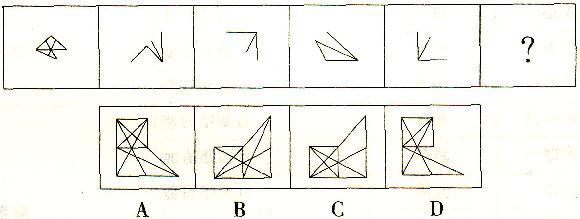
()
A.选项A
B.选项B
C.选项C
D.选项D答案:A解析:题干中第一个图形是解题关键点,在B、C、D中都找不到完整的第一个图形,只有A包含题干第一个图形。 -
第16题:
请从所给的选项中,选择唯一的-项填在问号处,使之呈现一定的规律性( )。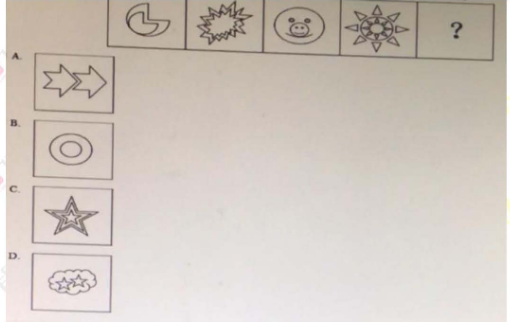 答案:B解析:本题考察数量+样式类。题千中图形都包含两个形状一样的图形, 但是大小.不一样,B选项两个一大一小的圆形符合题意,A选项两个大小一样,排除; C选项是三个形状一样的图形,排除; D选项有两个长得一样一个不一样,排除。所以答案为B选项。
答案:B解析:本题考察数量+样式类。题千中图形都包含两个形状一样的图形, 但是大小.不一样,B选项两个一大一小的圆形符合题意,A选项两个大小一样,排除; C选项是三个形状一样的图形,排除; D选项有两个长得一样一个不一样,排除。所以答案为B选项。
-
第17题:
图形推理。请按每道题的答题要求作答。
下题中缺少一个图。请从下边选项中选择一个插入上边图形中以使上边的图形逻辑角度上能成双配对。()。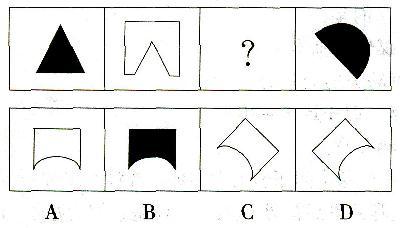
A.选项A
B.选项B
C.选项C
D.选项D答案:C解析:题干中,第一个图形是第二个图形缺失的一部分,而且颜色不同.不用旋转,由此推断,C答案正确。 -
第18题:
小学英语?阅读
一、考题回顾
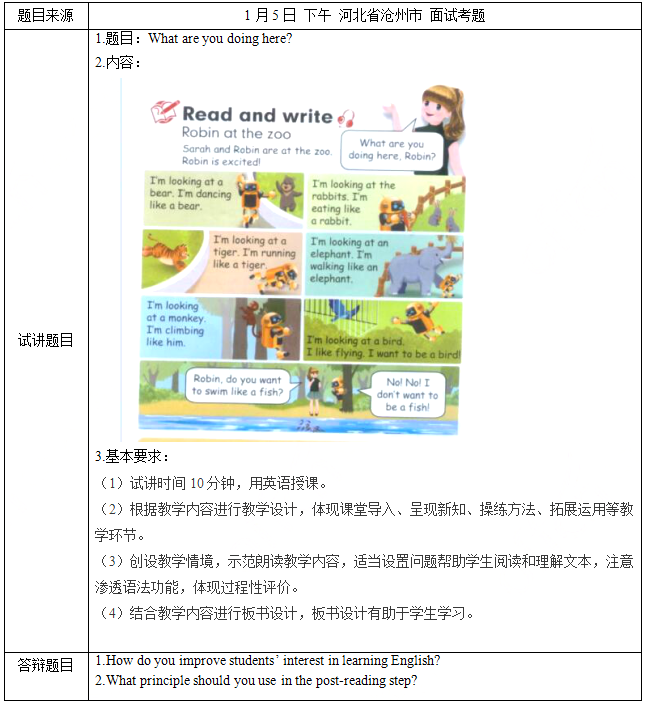
二、考题解析
【教学设计】
Teaching aims:
Knowledge aim:
Students will master the meaning and usage of the structure “be doing” through reading the passage.
Ability aim:
Students will apply the “be doing” to communicate with each other in real situation.
Emotional aim:
Students will be more interest in learning English.
Key and difficult point:
Key Point: Students will master how to improve reading abilities through finding main idea and details.
Difficult Point: Students will apply the “be doing” to communicate with each other in real situation.
Teaching procedure:
Step 1: Warming-up
1. Greetings.
2. Play a riddle and students guess the animals, such as “long nose, big ears and strong body——elephant”, then lead to the topic of “let’s go to the zoo to see what animals are doing”.
Step 2: Pre-reading
1. According to the title, students have a prediction about what kinds of animals are mentioned in the passage.
Step 3: While-reading
1. Fast reading: students read the passage fast and figure out what kinds of animals are mentioned in the passage then make a list.
2. Careful reading: students read the passage carefully and answer the question: what are the animals doing? Then fill in the blanks.
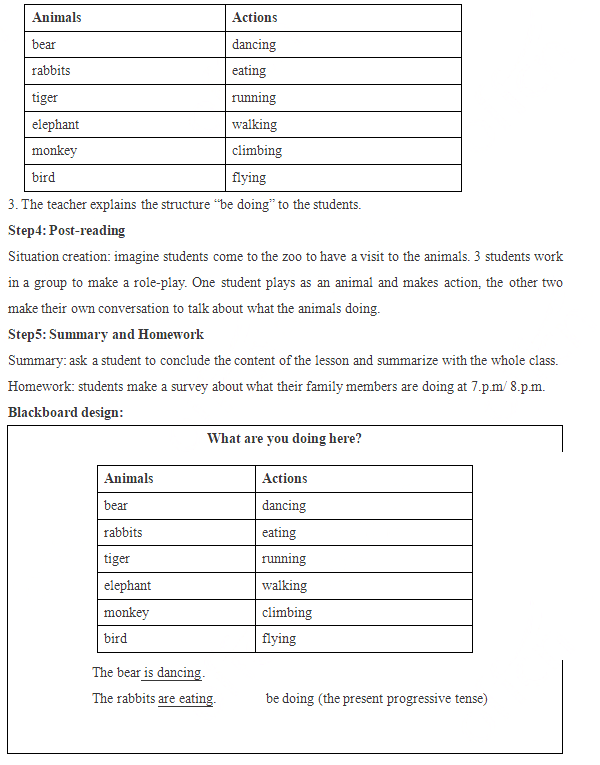
1. How do you improve students’ interest in learning English?
2. What principle should you use in the post-reading step?答案:解析:1.
In the process of English teaching, teachers should enrich the teaching approaches, not only teach students through "listening, speaking, reading", but also integrate situational teaching, so that students can feel the diversity of teaching and learning.
Besides, teachers can make use of the form of cooperative study and organize various practice activities in the classroom to create an atmosphere of mutual assistance and cooperation, so that students have positive sense of learning.
2.
First, we should persist in the communicative principle. In the production step of reading
class, students should be organized in groups to cultivate their speaking ability and communicative ability. In this way, we can reach the New Curriculum Standard.
Then, we should insist on the truth principle. That means we should provide more real materials that are closet to students’ real life, such as situation creation like what I did in this class. In this way, students’ interest can be aroused and they can apply what they’ve learned in real communication. -
第19题:
对于通过小额支付系统办理的本代他通存业务,若需调账,且该业务为转账通存,现金收取手续费,错账调整调整类型为挂账,则产生的会计分录为()。
- A、请对应上面图片内容选择对应选项
- B、请对应上面图片内容选择对应选项
- C、请对应上面图片内容选择对应选项
- D、请对应上面图片内容选择对应选项
正确答案:C -
第20题:
单选题Passage1Today's adults grew up in schools designed to sort us into the various segments of our social and economic system. The amount of time available to learn was fixed: one year per grade. The amount learned by the end of that time was free to vary: some of us learned a great deal;some,very little. As we advanced through the grades,those who had learned a great deal in previous grades continued to build on those foundations. Those who had failed to master the early prerequisites within the allotted time failed to learn that which followed. After 12 or 13 years of cumulative treatment of this kind,we were,in effect,spread along an achievement continuum that was ultimately reflected in each student's rank in class upon graduation.From the very earliest grades, some students learned a great deal very quickly and consistently scored high on assessments. The emotional effect of this was to help them to see themselves as capable learners, and so these students became increasingly confident in school. That confidence gave them the inner emotional strength to take the risk of striving for more success because they believed that success was within their reach. Driven forward by this optimism, these students continued to try hard, and that effort continued to result in success for them. They became the academic and emotional winners. Notice that the trigger for their emotional strength and their learning success was their perception of their success on formal and informal assessments.But there were other students who didn't fare so well. They scored very low on tests, beginning in the earliest grades. The emotional effect was to cause them to question their own capabilities as learners. They began to lose confidence, which, in turn, deprived them of the emotional reserves needed to continue to take risks. As their motivation warned, of course, their performance plummeted. These students embarked on what they believed to be an irreversible slide toward inevitable failure and lost hope. Once again, the emotional trigger for their decision not to try was their perception of their performance on assessments.Consider the reality-indeed, the paradox-of the schools in which we were reared. If some students worked hard and learned a lot, that was a positive result, and they would finish high in the rank order. But if some students gave up in hopeless failure, that was an acceptable result, too, because they would occupy places very low in the rank order. Their achievement results fed into the implicit mission of schools: the greater the spread of achievement among students, the more it reinforced the rank order. This is why, if some students gave up and stopped trying (even dropped out of school), that was regarded as the student's problem, not the teacher's or the school's.Once again, please notice who is using test results to decide whether to strive for excellence or give up in hopelessness. Thedata-based decision makers in this process are students themselves.Students are deciding whether success is within or beyond reach, whether the learning is worth the required effort, and so whether to try or not. The critical emotions underpinning the decision making process include anxiety, fear of failure, uncertainty, and unwillingness to take risks-all triggered by students' perceptions of their own capabilities as reflected in assessment results.Some students responded to the demands of such environments by working hard and learning a great deal. Others controlled their anxiety by giving up and not caring. The result for them is exactly the opposite of the one society wants. Instead of leaving no child behind, these practices, in effect, drove down the achievement of at least as many students as they successfully elevated. And the evidence suggests that the downside victims are more frequently members of particular socioeconomic and ethnic minorities.Which of the following will be triggered by the assessment results according to the passage?AStudents'learning efforts.
BLeaving-no-child-behind policy.
CSocioeconomic and ethnic ranking.
DSocial disapproval of schools'mission.
正确答案: D解析: -
第21题:
单选题Teachers should set a good example ______ their students, because what they do and say has a great effect ______ them.Afor; to
Bto; on
Cfor; in
Dto; to
正确答案: C解析:
句意:老师应该给学生树立一个榜样,因为无论他们做什么或说什么都会对学生产生巨大的影响。set an example to sb.为某人树立榜样。have a great effect on sb.对某人产生巨大的影响。故答案是B项。 -
第22题:
单选题What’s the overall goal of English teaching in basic education stage? _____AIncrease students’ vocabulary and grammar of the knowledge.
BImprove the students’ English learning and foreign cultural interesting.
CCultivate the students’ ability of listening and spoken English.
DCultivate students’ comprehensive capability of language.
正确答案: C解析:
基础教育阶段英语教学的总体目标是培养学生的综合语言运用能力。 -
第23题:
单选题对于通过小额支付系统办理的本代他通存业务,若需调账,且该业务为转账通存,转账收取手续费,错账调整调整类型为调账,则产生的会计分录为()。A请对应上面图片内容选择对应选项
B请对应上面图片内容选择对应选项
C请对应上面图片内容选择对应选项
D请对应上面图片内容选择对应选项
正确答案: C解析: 暂无解析 -
第24题:
单选题Passage1Today's adults grew up in schools designed to sort us into the various segments of our social and economic system. The amount of time available to learn was fixed: one year per grade. The amount learned by the end of that time was free to vary: some of us learned a great deal;some,very little. As we advanced through the grades,those who had learned a great deal in previous grades continued to build on those foundations. Those who had failed to master the early prerequisites within the allotted time failed to learn that which followed. After 12 or 13 years of cumulative treatment of this kind,we were,in effect,spread along an achievement continuum that was ultimately reflected in each student's rank in class upon graduation.From the very earliest grades, some students learned a great deal very quickly and consistently scored high on assessments. The emotional effect of this was to help them to see themselves as capable learners, and so these students became increasingly confident in school. That confidence gave them the inner emotional strength to take the risk of striving for more success because they believed that success was within their reach. Driven forward by this optimism, these students continued to try hard, and that effort continued to result in success for them. They became the academic and emotional winners. Notice that the trigger for their emotional strength and their learning success was their perception of their success on formal and informal assessments.But there were other students who didn't fare so well. They scored very low on tests, beginning in the earliest grades. The emotional effect was to cause them to question their own capabilities as learners. They began to lose confidence, which, in turn, deprived them of the emotional reserves needed to continue to take risks. As their motivation warned, of course, their performance plummeted. These students embarked on what they believed to be an irreversible slide toward inevitable failure and lost hope. Once again, the emotional trigger for their decision not to try was their perception of their performance on assessments.Consider the reality-indeed, the paradox-of the schools in which we were reared. If some students worked hard and learned a lot, that was a positive result, and they would finish high in the rank order. But if some students gave up in hopeless failure, that was an acceptable result, too, because they would occupy places very low in the rank order. Their achievement results fed into the implicit mission of schools: the greater the spread of achievement among students, the more it reinforced the rank order. This is why, if some students gave up and stopped trying (even dropped out of school), that was regarded as the student's problem, not the teacher's or the school's.Once again, please notice who is using test results to decide whether to strive for excellence or give up in hopelessness. Thedata-based decision makers in this process are students themselves.Students are deciding whether success is within or beyond reach, whether the learning is worth the required effort, and so whether to try or not. The critical emotions underpinning the decision making process include anxiety, fear of failure, uncertainty, and unwillingness to take risks-all triggered by students' perceptions of their own capabilities as reflected in assessment results.Some students responded to the demands of such environments by working hard and learning a great deal. Others controlled their anxiety by giving up and not caring. The result for them is exactly the opposite of the one society wants. Instead of leaving no child behind, these practices, in effect, drove down the achievement of at least as many students as they successfully elevated. And the evidence suggests that the downside victims are more frequently members of particular socioeconomic and ethnic minorities.What has made students spread along an achievement continuum according to the passage?AThe allotted time to learn.
BSocial and economic system.
CThe early prerequisites students mastered.
DPerformance on formal and informal assessments.
正确答案: D解析:
